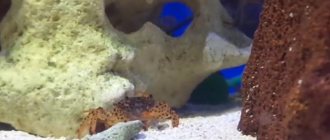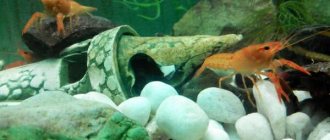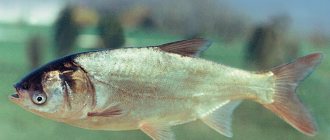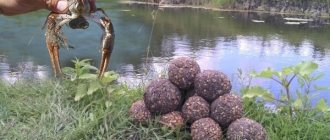Crustaceans are interesting creatures that lead a secretive lifestyle and are characterized by incredible diversity - large and small, poisonous and edible, useful and harmful.
These animals are found in almost every corner of the planet. What tastes better?
- Crab meat 66%, 263 votes
263 votes 66%263 votes - 66% of all votes
- Crab sticks 34%, 133 votes
133 votes 34%
133 votes - 34% of all votes
Total votes: 396
29.11.2019
- Crab meat 66%, 263 votes
263 votes 66%263 votes - 66% of all votes
- Crab sticks 34%, 133 votes
133 votes 34%
133 votes - 34% of all votes
Total votes: 396
29.11.2019
×
You or from your IP have already voted.
They have been known to mankind for a very long time. Crabs are one of the oldest inhabitants of our planet. The fossils found confirm that they lived during the Jurassic period.
Structure of a crab
Externally, crabs differ from crayfish in the structure of their abdomen - it is small and tucked under the chest. These crustaceans have 10 limbs, of which two claws are used for grasping food, and the rest are walking legs. Almost all of them live in water and breathe using gills. An interesting feature is that on land they breathe not the air around them, but the air that has accumulated in the cavities of the gills.
A crab's shell is its skeleton, just on the outside. He plays not only a defensive role, but also a supporting one. They have ten limbs and a pair of claws.
In battles with enemies, the crab may lose its claw, but it will subsequently grow back. This explains the fact that many individuals have one claw larger than the other.
The body, protected by a chitinous shell, passes into the cephalothorax. The eyes are located on stalk-like processes and have a complex facet structure, that is, they consist of many ocelli, information from which enters the brain. Most crabs have a flat body, which allows them to find shelter under rocks.
During the molting period, these crustaceans shed their shells and become defenseless for some time. In an effort to protect their vulnerable body, they hide in secluded places - crevices, empty shells, holes dug under stones.
Male crabs can be very aggressive towards each other, this trait is especially pronounced during the breeding season.
Despite the powerful protection provided by the shell, crabs have many enemies in their natural environment. They are hunted by octopuses, sea otters, and some types of fish. Human harvesting of crabs is a serious threat to the population. Many varieties are listed in the Red Book and are protected by law. As a defense, many crustaceans use camouflage; their color matches their habitat - sand, stones, and so on.
There are crabs that have adapted to defend themselves with the help of other inhabitants of the seabed, such as sea anemones. The crabs land them on their backs or claws and expose them to the enemy in case of danger.
They most often move sideways, with their claws pointed forward for protection. They are able to develop quite high speed, which allows them to catch up with prey.
Interesting Facts
- A distinctive feature of Kamchatka crab is its caviar, light purple in color, reminiscent of grapes.
- In the USSR, a biological campaign was carried out to relocate the Kamchatka crab to the Barents Sea.
- Kamchatka crab is exported to eastern countries, as well as major Russian cities and local markets.
- They are long-lived, as they live up to 20 years. At the same time, the population is quite high, despite the high level of crab catch by fishing vessels.
- Crabs are highly fertile, which stimulates the fishery and allows it to grow from year to year, without loss of population.
- Crab shells can be processed and turned into flour, which is used in the food industry.
- The male can shed his shell in a matter of minutes; this takes him about 10–12 minutes. At such moments, he is especially vulnerable, and can become a tasty morsel for marine life.
- In a female, the change of shell can last about a week. If she has a patron who supports the female with his claws and protects her, then he will soon take the place of the spouse.
- The size of the head is very small in comparison with the rest of the body, and the stomach is located in the head.
Where do they live?
Over the many millions of years during which this class has existed on the planet, its representatives have perfectly adapted to different living conditions. They can be found in the seas of all oceans, in different climatic zones - from the tropics to the Arctic and Antarctic, in waters of different salinity and temperature.
Most crustaceans live in the seas, but there are species that have adapted to life in fresh waters - Japanese or Chinese mitten crabs. They were accidentally brought with ballast waters to Europe and settled along the western shores. This crab is often found in the rivers of Sweden, Germany, and France.
There are even land species. This is the palm thief. Its larvae live in the sea, and adults move to land, entering the water only to reproduce. They have become so comfortable on the shore that they deftly climb palm tree trunks in search of food.
Home content
On the one hand, this is still exotic, and there are practically no specialists in the field of crab science. On the other hand, they keep frogs and newts, turtles and other creatures at home that once seemed completely unsuitable for an aquarium. Moreover, they also get along peacefully with fish.
Speaking about what crabs eat, it is worth remembering that in nature these creatures are completely omnivorous. They will happily eat insects, baby other crabs, berries or algae for breakfast. They will definitely check almost everything that comes their way to see if it is edible.
Nutrition and reproduction
Crabs, like many other crustaceans, are omnivorous predators and feed primarily on bottom dwellers because they are easier to catch. Everything that can be caught and grabbed is eaten. Most often they feed on:
- aquatic invertebrates;
- sea urchins;
- small crustaceans;
- shellfish;
- small fish;
- sea stars.
Large individuals can feast on even a gaping bird. Crabs also play the role of coastal orderlies, as they eat not only living but also dead animals.
Crabs are dioecious animals. Reproduction in most species occurs in the spring. Let's consider this process using the example of Kamchatka crab. To attract females, males perform a kind of dance, clapping their claws. Then the animals take a mating stance - they are located opposite each other and touch their claws. They spend 3-7 days this way.
After this, the males help the females shed their old shell and begin mating. The male secretes and attaches a spermatophore, a long sac in an insoluble shell, to the female’s legs, after which the crabs disperse. Next, the female lays eggs, the number of which ranges from several tens of thousands to 300 thousand pieces. It also secretes a special liquid to dissolve the spermatophore membrane.
One mating may be enough for a female to lay eggs for the rest of her life. The fertilized eggs are attached to the female's legs, while the rest are still located in the ovaries. The eggs develop during the warm season; in cold weather, development stops. On average, the female wears them for 11.5 months, then sheds them. Only 10% of the eggs survive, the rest become prey for fish.
Hatched larvae have an elongated body and are unlike adults. For about two months they move thanks to the current, molting four times during this time. Then they sink to the bottom and molt occurs approximately once every twenty days. With each moult, the juveniles acquire more and more characteristic features and look like a crab.
The larger the crustacean, the more time it takes for the larva to transform into a sexually mature individual. Thus, Kamchatka crabs begin to migrate at the age of 5-6, and females are ready to reproduce at 8 years, males at 10.
What does it eat?
The Kamchatka crab is an omnivore; it prefers to eat a variety of mollusks, plankton, worms, sea urchins, crustaceans, ascidians, small fish, and starfish. Young individuals eat algae and hydroid organisms, worms. The food goal forces animals to make mass movements. With the help of powerful claws, the crustacean kills its prey. In cases of lack of live food, it feeds on carcass remains from fish and various organisms. The animal has a unique feature of adapting to different foods. So, while waiting to molt, the crab looks for food containing a high level of calcium.
Its frame is highly durable and provides a high level of protection, but does not allow the body to grow between shell changes. Therefore, the crab can only grow in a short period of time, which lasts up to 72 hours. At this time, the animal sheds the old frame, and the new one is easily stretchable and does not prevent the crab from growing. After this, the chitin cover gradually strengthens and stiffens due to calcium salts. Then the growth of the Kamchatka crab stops.
Types of crabs
Not all crustaceans are suitable for consumption; some are poisonous. Let us list the types of crabs that are the subject of fishing.
Barbed
Lives in the northeastern part of the Pacific Ocean. Feels good in water of low salinity, sometimes found even in fresh waters - it gets caught in nets when fishing for salmon. Most often found off the coast of Kamchatka, the Kuril Islands and Sakhalin. The spiny crab settles in places with rocky soil. It prefers to be in shallow water - no more than 20-25 meters, although there have been cases when this species was caught at a depth of 340 meters. Usually leads a sedentary lifestyle. Perfectly adapted to seasonal changes in water temperature. The shell of this crustacean is covered with sharp spines and can reach 12-15 cm in width. It feeds mainly on small mollusks.
Peculiarities
In summer, crabs flock en masse to shallow water, and in winter they move deeper into the ocean. They can dive to a depth of 300 m. Thanks to this feature, Kamchatka crabs lead an active life and do not hibernate.
They can move at an average speed of up to 5 km per day. During mass movement along the bottom, the speed remains at the same level.
Kamchatka crab is a slow-growing animal; the key growth factor is water temperature. Thus, in America, crabs living in warm water grow much faster than in Russia, living in the cold waters of Kamchatka.
Nautical
In Russia, crustaceans are often found in the Black Sea. The main types found there:
- marble sea crab - has a small size of up to 5 cm and a pattern on the shell that resembles marble, which is clearly visible in the photo;
- water lover, or lilac crab; reaches 6 cm, practically does not reach land;
- The diving beetle is found in sandy places and burrows well into the ground;
- the grass prefers shallow water and grass thickets, is the fastest representative of arthropods, moves at a speed of 1 meter per second;
- stone. This is the largest Black Sea crab, its shell grows up to 15 cm and is covered with spines and growths. The color may be red or brown. It has very strong claws that are capable of lifting prey that is larger and heavier than a crab. It is a commercial species, its meat is very tasty.
Royal
The full name of this species is blue king crab. It is associated with coloring - large blue spots on a brown background. The abdomen is white. This animal is quite large in size, males reach a weight of 4.5 - 5 kg. Females weigh significantly less - about one and a half kilograms.
Pacific
Traditionally, the Pacific Ocean refers to the same Kamchatka crab, which has several names, but in the Pacific Ocean, in addition to it, there are several other interesting varieties of crabs:
- velvet floating;
- xantho;
- large land
- Chinese furry-armed.
Kamchatka or Imperial
The Kamchatka crab is classified as a hermit crab of the craboid family. This is one of the largest representatives of its species. The size of an adult individual reaches 25 centimeters in body width and one and a half meters in leg span. Weight can reach up to 7.5 kg in males. The female weighs 4.5 kg. The body includes the cephalothorax and abdomen. The shell in the area of the heart and stomach is protected by sharp spines. It has five pairs of legs, four for locomotion and one for cleaning the gills. The claws differ in purpose - the right one is for breaking shells, the left one is for soft food.
Once a year the animal molts, shedding its old shell. The process lasts about three days. Vulnerable females are guarded by males during molting. During molting, the animal also renews the lining of the stomach and heart, and the tendons change. The younger the animal, the more often it sheds - up to 12 times in the first year of life, then once every two months in the second year, and later - once every two years.
The Kamchatka crab is found in the Sea of Japan, Okhotsk and Bering Seas. In the 60s of the 20th century it was settled in the Barents Sea. Such attempts were made back in 1951, but were unsuccessful. In 1960, the first Kamchatka crabs took root and acclimatized, but 90% of the eggs died. Subsequently, only adult individuals were imported.
Nowadays, the population of this species in the Barents Sea is rapidly growing and spreading; Kamchatka crabs have begun to be found even off the coast of Norway. It lives at a depth of 5 meters in the warm season to 250 meters in the cold, prefers a flat sandy bottom. The Kamchatka crab constantly migrates, but does not change its route. For more than a hundred years, this crab has been the best for fishing.
Frog
Outwardly, this animal looks like a frog - a large shell and small claws, shaped like pliers. The color is orange or red. It can move forward and backward, unlike most other relatives, which move sideways. Prefers desert places and depths up to 100 m. They spend most of the day buried in the sand. Selected only for food, they live in the Indian Ocean.
Snow
Its other name is opilio, or snow crab, and has a white tint. It lives in Russia in the Barents Sea and the western part of the Atlantic Ocean. In cold waters it is found at a depth of 10-20 meters, in warmer regions - 1200 meters. Reproduction always occurs at the depth where crabs live. After mating, the animals die and live no more than 5-6 years. In recent years, their numbers have greatly decreased due to uncontrolled catching; there is a ban on catching females or individuals whose shell length does not reach 10 cm.
Equal-spike
It mainly lives at a depth of about 500 meters. The animal’s lifestyle is sedentary; the animal does not migrate, since the water temperature in its habitat practically does not fluctuate. The animal got its name because of the growths on its body - they are all the same size and evenly cover the shell. Its color is golden yellow, the size of an adult male can reach 7 kg, females are half that size.
Description
It is given third place in the world in terms of fishing. They are distinguished by their agility and strength when circumstances require it.
The Kamchatka crab is the largest representative of crustaceans; it is also called “king crab” due to its impressive size. The life of a marine inhabitant is interesting from the point of view of its biological ability to successfully undergo artificial relocation. It is of great economic importance from a fishing point of view. Hermit crabs, which are related to craboids, are considered direct relatives.
They are distinguished by their large sizes, up to 30 cm wide and up to 1.5 meters long.
The smallest crab in the world
The pea crab got its name due to its small size - less than 2.5 cm. It is so small that it is often found in the shells of live oysters, another name for them is oysters. In this way the crab protects itself from predators. Another advantage of this symbiosis is that the pea crab receives food, and it does not eat the mollusk itself, but its prey. The shape of the shell resembles a pea. Females are light pink in color, and males are brown, as in the photo.
Applications of crabs
Crab meat is a very valuable food product and accounts for 40% of its weight. In total, approximately 1.5 million tons of them are caught and grown annually in the world.
When raw, the meat looks like jelly and has a grayish color; it is usually eaten after boiling. It contains essential amino acids and glycogen, which gives it a pleasant sweet taste. Meat also contains high levels of biologically active phosphorus, sulfur and magnesium. The edible parts of the crustacean's body are the limbs and the stomach. Under the shell, the body is covered with a red film, which would transform into a new shell during the molting period.
Crab meat is useful for anemia, blurred vision and diseases of the cardiovascular system.
Due to its low calorie content, it is dietary; 100 grams contains only 73 kcal, 18.3 grams of protein and 0.6 grams of fat.
But this seafood can also be dangerous. Crustaceans are not only predators, but also scavengers. By feeding on the remains of animals, they can become infected with various infections and parasites. If you eat the meat of a sick animal, you can get various complications - poisoning, loss of vision and hearing, nervous system disorder.
Crab meat should not be eaten by people suffering from seafood intolerance.










